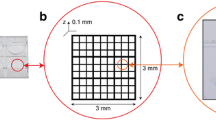Abstract
The death of the hybridoma VO 208 in a continuous culture at pH 7 and 6.8 was investigated by measuring both the appearance of visible dead cells which do not exclude the trypan blue dye and the release of lactate dehydrogenase (LDH) in the culture medium. The intracellular LDH was found to be completely released either when live cells lysed or when they were transformed into visible dead cells. No significant lysis of blue dead cells could be observed at the two different pH. Using a LDH balance over the culture system, cell lysis was found negligible at pH 7, but accounted for 20% of the total cell death at pH 6.8. A methodology is proposed to evaluate the rate constants of hybridoma lysis and total death. For the investigated cell line in continuous culture, the calculated total cell death rate constant was found to increase from 0.002 h−1 to 0.01 h−1 when decreasing the pH from 7 to 6.8.
Similar content being viewed by others
Abbreviations
- D:
-
dilution rate (h−1)
- kb :
-
specific trypan-blue dead cells appearance rate (h−1)
- kL :
-
specific lysis rate of viable cells (h−1)
- kd :
-
specific death rate (h-1)
- LDH0 :
-
lactate dehydrogenase activity in the feed culture medium (IU.l−1)
- LDH:
-
lactate dehydrogenase activity in the outlet culture medium (IU.l−1)
- LDHi :
-
intracellular lactate dehydrogenase activity of viable cells (IU.10−9 cells)
- rLDH :
-
total rate of LDH release (IU.h−1.L−1)
- rb :
-
transformation rate of viable cells into blue dead cells (109 cells.h−1.L−1)
- xv :
-
viable cell concentration (109 cells.l−1)
- xb :
-
trypan-blue dead cell concentration (109 cells.l−1)
References
Akatov VS, Lezhnev EI, Vexler, AM and Kublik LN (1985) Low pH value of pericellular medium as a factor limiting cell proliferation in dense cultures. Exp. Cell. Res. 160:412–418.
Bour JM, Maugras M, Capiaumont J, Dousset B, Straczek J, Gelot MA and Nabet P (1989) Marqueurs biochimiques de la prolifération et de la mort des hybridomes en culture. BioSciences 7:35–40.
Bursch W, Kleine L and Tenniswood M (1990) The biochemistry of cell death by apoptosis. Biochem. Cell Biol. 68:1071–1074.
Cook JA and Mitchell JB (1989) Viability measurements in mammalian cell systems. Anal. Biochem. 179:1–7.
Eagle H (1973) The effect of environmental pH on the growth of normal and malignant cells. J. Cell. Physiol. 82:1–8.
Franek F and Dolnikova J (1991) Hybridoma growth and monoclonal antibody production in iron rich protein-free medium: effect of nutrient concentration. Cytotechnology 7: 33–38.
Franek F, Dolnikova J and Vomastek T (1992) Hybridoma culture in iron rich protein-free medium: cell growth, apoptosis, and nature of macromolecules recovered from the culture fluid. In: Murakami H (ed.) Animal Cell Technology: Basic and Applied Aspects (pp. 303–309) Kluwer Academic Publishers, Dordrecht.
Geaugey V, Pascal F, Engasser J-M and Marc A (1990) Influence of the culture oxygenation on the release of LDH by hybridoma cells. Biotechnol. Techn. 4:257–262.
Goergen J-L, Marc A and Engasser J-M (1992a) Influence of medium composition on the death and lysis of hybridoma cells in continuous culture. In: McDonald C, Griffiths JB, Spier RE (eds.) Animal Cell Technology: Development, Processes and Products. (pp. 122–124) Butterworth, London.
Goergen J-L (1992b) Ph.D. Thesis. Institut National Polytechnique de Lorraine. Cultures continues d'hybridomes: études cinétiques et modélisation de l'influence de paramètres physico-chimiques sur la croissance, le décès et le métabolisme des cellules.
Marc A, Wagner A, Martial A, Goergen J-L, Engasser J-M, Gaugey V, Pinton H (1991) Potential and pitfalls of using LDH release for the evaluation of animal cell death kinetics. In: Spier RE, Griffiths JB and Meignier B (eds.) Production of Biologicals from Animal Cells in Culture. Research, Developments and Achievements (pp. 569–575) Butterworth, London.
Miller WM, Blanch HW and Wilke CR (1988) A kinetic analysis of hybridoma growth and metabolism in batch and continuous suspension culture: Effect of nutrient concentration, dilution rate and pH. Biotechnol. Bioeng. 33:947–965.
Pialkowski SE (1988) Real time digital filters. Anal. Chem. 60: 355A-361A.
Racher AJ, Looby D, Griffiths JB (1990) Use of LDH release to assess changes in culture viability. Cytotechnology 3: 301–307.
Thomas JE and Roberts RS (1989) Effect of hyperosmotic pressure on growth of L5178 Y cells. Process Biochem. 24: 179–182.
Wagner A, Marc A and Engasser J-M (1992) The use of lactate dehydrogenase (LDH) release kinetics for the evaluation of death and growth of mammalian cells in perfusion reactors. Biotechnol. Bioeng. 39:320–326.
Yuhas JM, Toya RE and Pazmino NH (1974) Neuraminidase and cell viability: failure to detect cytotoxic effects with dyeexclusion techniques. J. Natl. Cancer Inst. 53:465–468.
Author information
Authors and Affiliations
Rights and permissions
About this article
Cite this article
Goergen, J.L., Marc, A. & Engasser, J.M. Determination of cell lysis and death kinetics in continuous hybridoma cultures from the measurement of lactate dehydrogenase release. Cytotechnology 11, 189–195 (1993). https://doi.org/10.1007/BF00749869
Received:
Accepted:
Issue Date:
DOI: https://doi.org/10.1007/BF00749869




